German rocket artillery during the war. 1-Part I
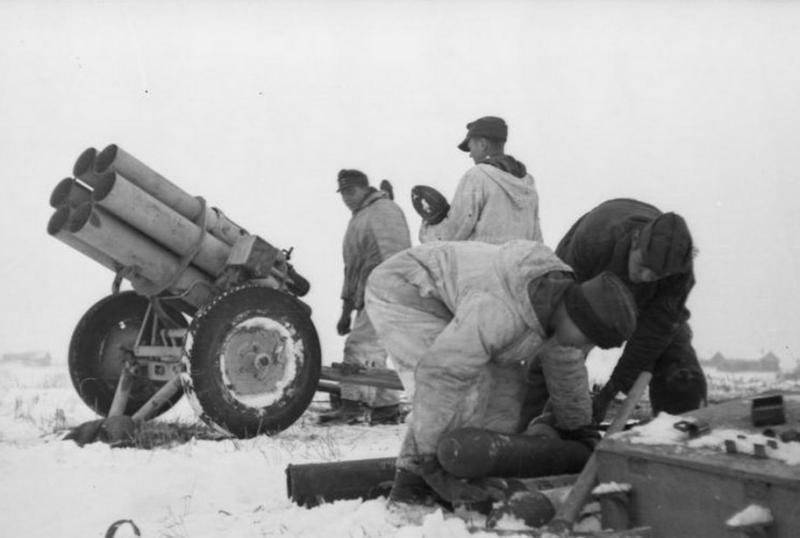
Created before the Second World War in Germany, multiple rocket launchers (MLRS) were originally intended for firing projectiles equipped with chemical warfare agents and projectiles with a smoke-forming compound for the installation of smoke screens. However, in fairness it should be noted that the Soviet MLRS BM-13 (the famous "Katyusha") was created with similar goals. This is reflected in the name of the first German serial 150-mm MLRS - Nebelwerfer or “smoke mortar type D”. The literal translation of the name “Nebelwerfer” from German is “Tumanomet”.
During the Second World Germany, yielding to the allies in total stocks of accumulated chemical weapons, had a significant qualitative superiority in this area. The traditionally high level of development of the German chemical industry and the presence of an excellent theoretical base allowed German chemists to make a breakthrough in the field of chemical warfare agents at the end of the 30s. In the course of research on the creation of means for combating insects, the most deadly type of poisonous substances in service was discovered - nerve-paralytic poisons. Initially, a substance was synthesized, which later became known as “Tabun”. Later even more poisonous were created and produced on an industrial scale: “Zarin” and “Soman”.
Fortunately for the Allied armies, the use of poisonous substances against them did not take place. Germany, destined to be defeated in the war by conventional means, did not attempt to change the course of the war in its favor by using the latest chemical weapons. For this reason, the German MLRS used only high-explosive, incendiary, smoke and agitation mines for firing.
The six-barreled 150-mm mortar tests began in the 1937 year. The installation consisted of a package of six tubular guides mounted on a converted 37 mm carriage of 3.7 cm PaK 36 anti-tank guns. Six trunks 1,3 long meters were combined into a block using the front and rear clips. The carriage was equipped with a lifting mechanism with a maximum elevation angle of 45 degrees and a turning mechanism that provided a horizontal angle of fire to 24 degrees.
In a combat position, the wheels hung out, the carriage rested on the bipod of the sliding bed and the folding front stop.
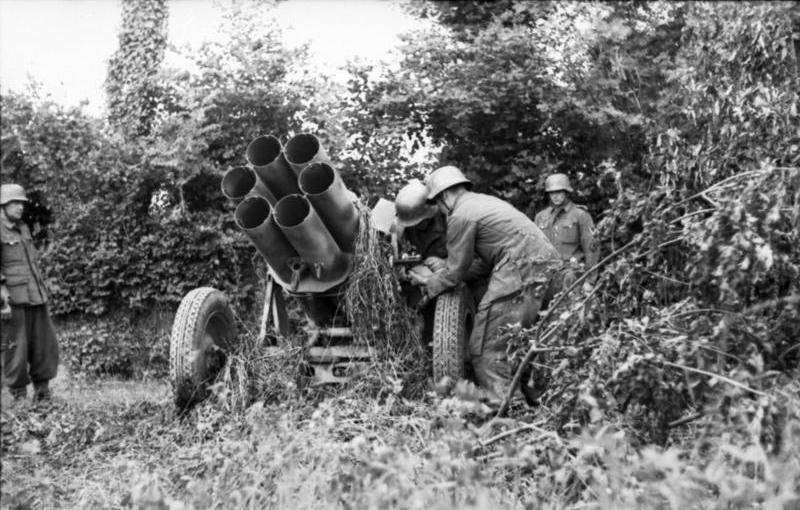
Combat weight in the curb position reached 770 kg, in the stowed position, the figure was equal to 515 kg. For short distances, the installation could roll by the forces of calculation.
150-mm turbojet mines (rockets) were used for firing. The warhead was located in the tail, and in the front - a jet engine, equipped with a perforated bottom with 26 inclined holes (nozzles, inclined at an angle 14 degrees). A ballistic cover was put on the engine. Stabilization of the projectile in the air was due to the obliquely located nozzles, providing rotation at a speed of about 1000 rev / sec.
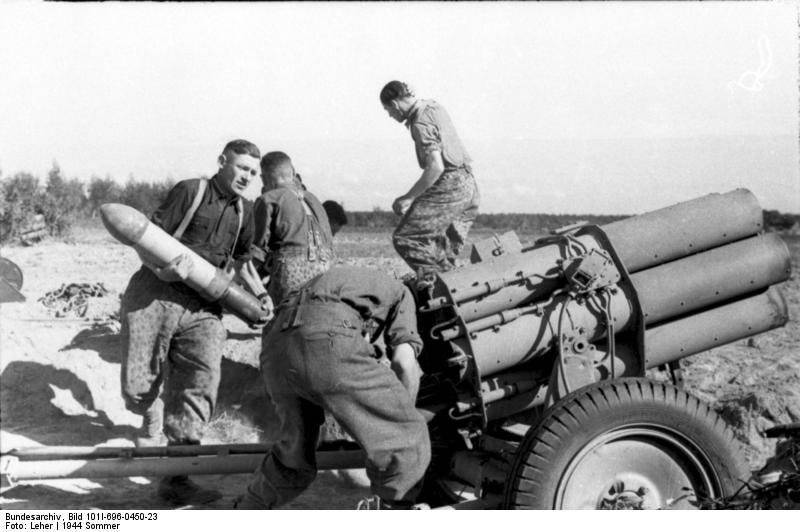
The main difference between the German missiles from the Soviet was a method of stabilization in flight. Turbojet missiles had a higher accuracy, since this method of stabilization at the same time allowed to compensate for the eccentricity of the engine thrust. In addition, it was possible to use shorter guides, since, unlike the missiles stabilized by the tail, the effectiveness of stabilization did not depend on the initial velocity of the rocket. But due to the fact that part of the energy of the exhaust gases was spent on the unwinding of the projectile, the range of its flight was less than the projectile with feathers.
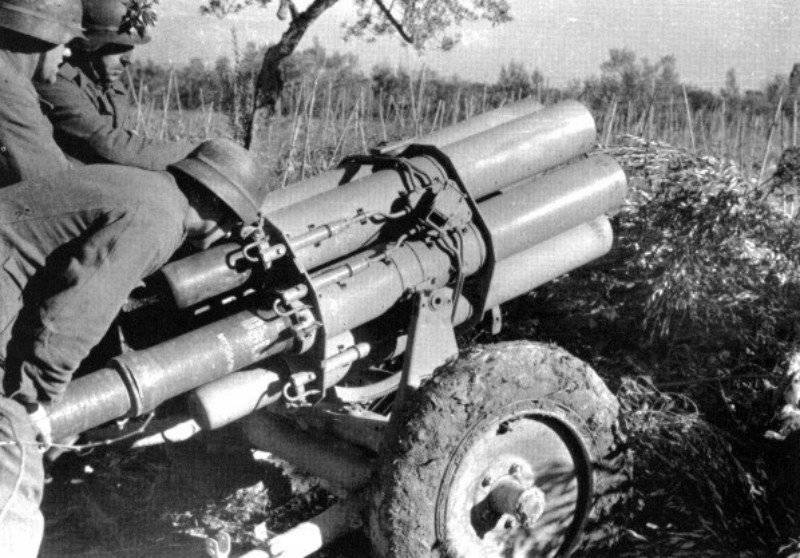
When loading the rocket mines from the breech, projectiles were fixed by special holders, after which an electric nozzle was inserted into one of the nozzles. After pointing the mortar at the target, the calculation went into cover and, with the help of the launch unit, fired mines at 3 in series. The ignition of the igniter during start-up occurs remotely from the vehicle battery towing the installation. The volley lasted about 10 seconds. Recharge time - up to 1,5 minutes (ready for the next volley).
Initially, black powder compressed under high temperature (at the melting point of sulfur) was used as a jet fuel. The low strength of the powder bar and the presence of a significant number of voids in it led to the formation of cracks, which led to frequent accidents at launch. In addition, the burning of this fuel was accompanied by abundant smoke. The black powder bars in 1940 were replaced with tubular pieces made from smokeless diglecole powder, which had the best energy qualities. As a rule, seven powder pieces were used.
The maximum range of a missile weighing 34,15 kg (smoke - 35,48 kg) missiles was 6700-6800 meters at the highest flight speed 340 m / s. Nebelwerfer had a very good accuracy for the MLRS of the time. At a distance of 6000 m, scattering of shells along the front is 60-90 m, and at a distance of 80-100 m. Scattering of fragmentation of high-explosive mines was 40 meters along the front and 13 meters forward from the point of rupture. In order to achieve the maximum damaging effect, shooting was ordered only by battery or sub-divisional.
The first parts, which were armed with six-barrel mortars, were formed at the beginning of 1940 of the year. For the first time this weapon was used by the Germans during the French campaign. In the 1942 year, after entering the 28 / 32 cm Nebelwerfer 41 MLRS, the installation was renamed 15-cm Nb.W. 41 (15-cm Nebelwerfer 41).
In 1942, three regiments (Nebelwerferregiment) were deployed as part of the German army, as well as nine separate divisions (Nebelwerfeabteilung). The division consisted of three 6 PU, the regiment consisted of three divisions (54 "Nebelverfera"). From 1943 onwards, 150-mm rocket launchers (6 PU) batteries began to be included in the light divisions of artillery regiments of infantry divisions, replacing 105-mm field howitzers in them. As a rule, one division had two MLRS batteries, but in some cases their number was reduced to a three-battery division. In addition to strengthening the artillery of the infantry divisions, the Germans also formed separate parts of the rocket mortars.
In total, the German industry has managed to produce 5283 six-barrel 150-mm installations of Nebelwerfer 41 and 5,5 million missiles to them.
Relatively light, having high firepower of the MLRS Nebelwerfer performed well during the landing on Crete (Operation Mercury). On the Eastern Front, they were in service with the 4 th Special Purpose Chemical Regiment and from the first hours of the war were used to bombard the Brest Fortress, firing high-explosive mines over 2880.
Due to the characteristic sound of flying shells, the Nebelwerfer 41 received the nickname “Ishak” from Soviet soldiers. Another colloquial name is “Vanyusha” (by analogy with “Katyusha”).
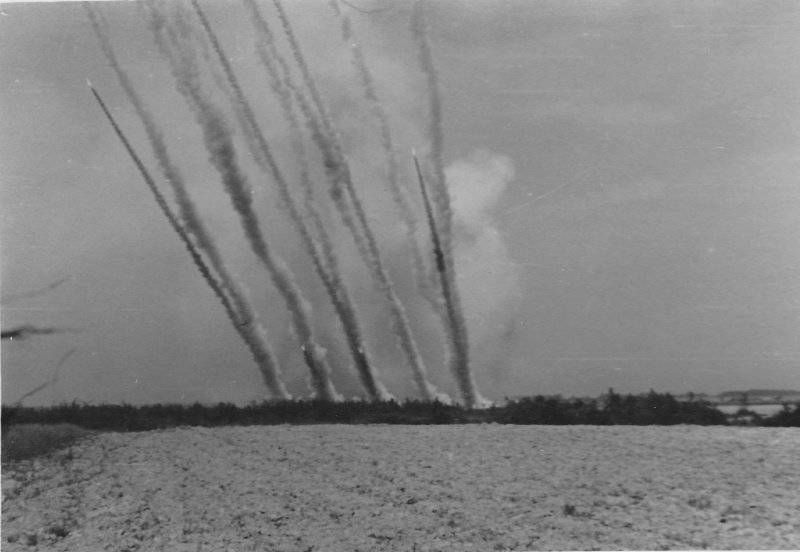
A big drawback of the German 150-mm six-barreled mortar was a characteristic, well-marked smoke trail when fired, serving as an excellent reference for enemy artillery. Given the low mobility of the Nebelwerfer 41, this flaw often became fatal.
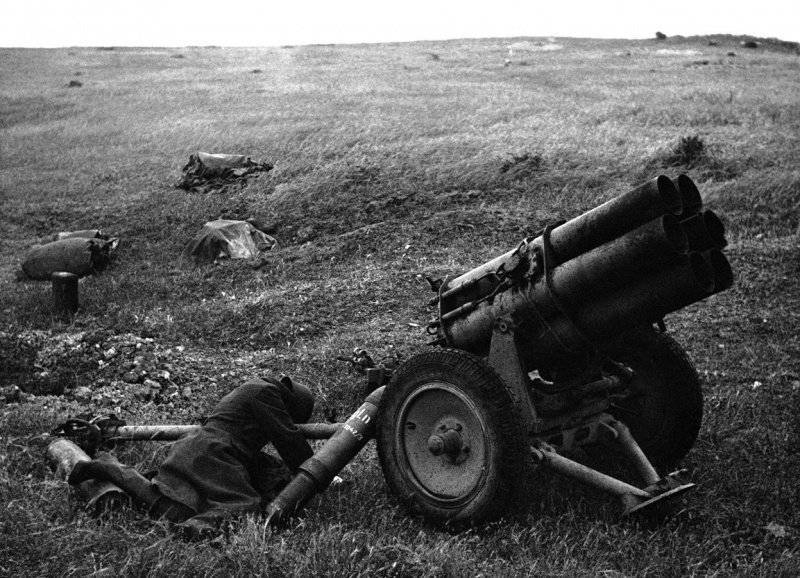
In order to increase the mobility and security of the calculation, a self-propelled 1942cm MLRS Panzerwerfer 15 Auf.Sf or Sd.Kfz.42 / 4 with a combat weight of 1 tons was created on the basis of the semi-tracked Opel Maultier truck. The launcher consisted of ten trunks arranged in two rows, connected in one block by two clips and a casing.
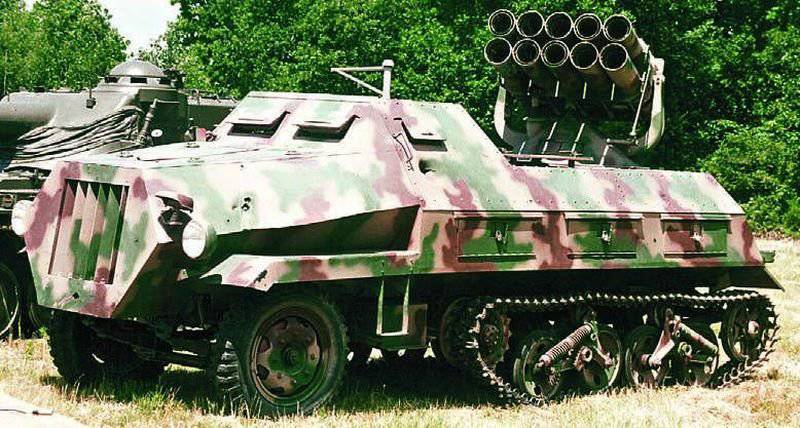
The Panzerwerfer 42 was protected by 6-8-mm splinter armor. For self-defense and firing at anti-aircraft targets above the driver's cabin there is a bracket for mounting the X-NUMX-mm MG-7,92 machine gun. The crew consisted of four people: the commander of the car (he is also a radio operator), gunner, loader and driver.
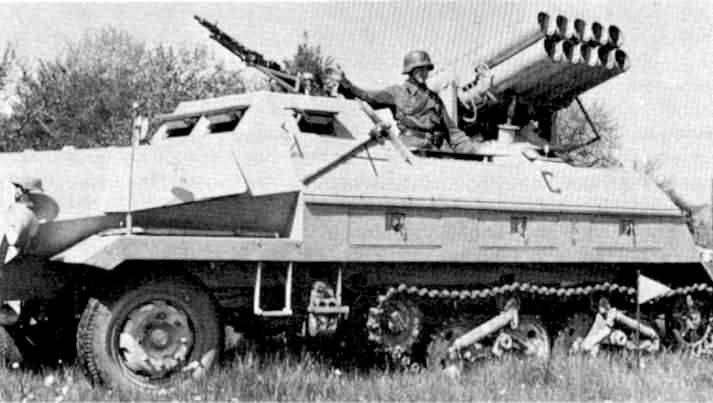
During serial production in 1943 — 1944, 296 combat vehicles were produced, as well as a 251 carrier for ammunition on the same base. Panzerwerfer were actively used by German troops until the end of the war.
In addition to the Opel chassis, the self-propelled version of the MLRS was produced on the basis of a standard 3-ton army tractor (3-ton schwerer Wehrmachtschlepper), a semi-tracked armored personnel carrier used by the troops to transport ammunition. Serial production has been carried out since 1944 by Bussing-NAG and Tatra. It continued until the very end of the war. The machine, protected by 15-mm armor, turned out to be poorly maneuverable and slow-moving, since the combat mass reached 14 tons.
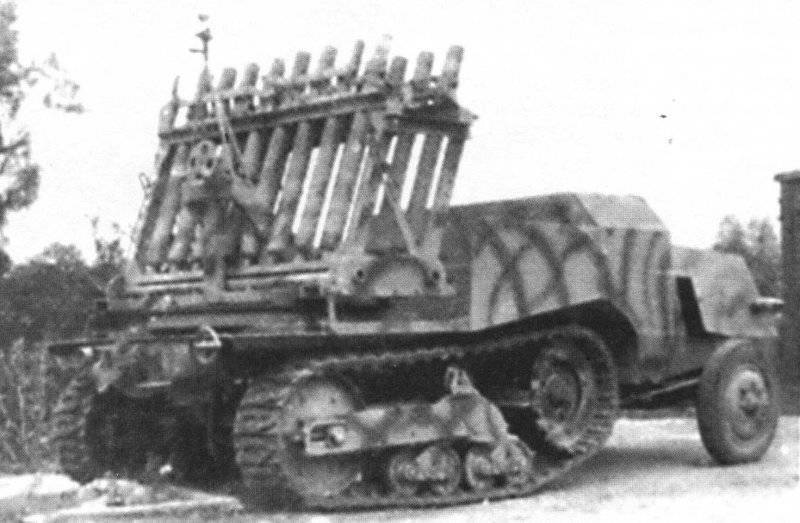
150-mm self-propelled MLRS was also produced on the basis of the captured half-crawler tractor SOMUA MCG / MCL.
In order to increase the destructive effect of rockets in 1941, a six-barreled 28 / 32 cm Nebelwerfer 41 was adopted. On the wheeled carriage, with a fixed frame frame, was attached a two-tier trunnion farm. Guides fit into both 280-mm high-explosive and 320-mm incendiary missiles. The mass of the unmounted unit reached the entire 500 kg (the guides had a non-tubular, but a lattice design), which allowed it to freely roll it onto the battlefield by the forces of calculation. The combat weight of the system: 1630 kg in mortar equipped with 280-mm ammunition, 1600 kg - 320-mm. The horizontal fire sector was 22 degrees, the elevation angle was 45 degrees. A volley of 6 missiles took 10 seconds, reloading was done within 2 and a half minutes.
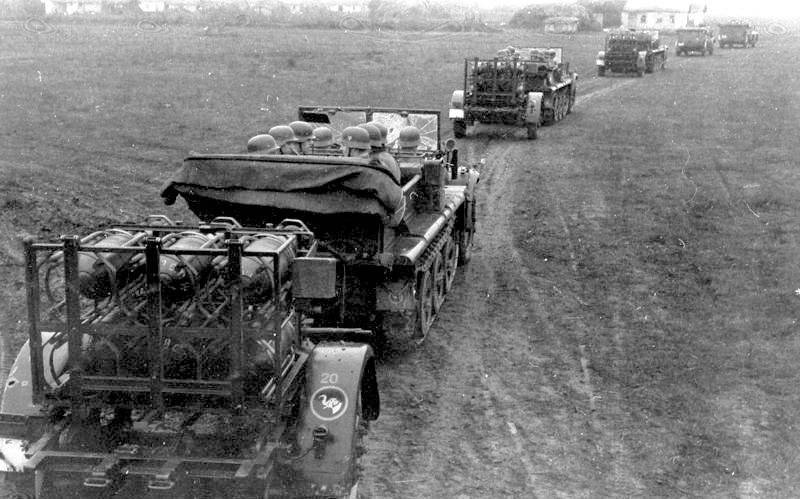
When building 280-mm and 320-mm missiles, a well-developed engine from 158-mm 15cm Wurfgrante missiles was used. Since the mass and frontal resistance of the new missiles were much larger, the firing range decreased by about three times and was 1950-2200 meters at a maximum speed of 149-153 m / s. Such a range allowed firing only at targets on the line of combat contact and in the immediate rear of the enemy.
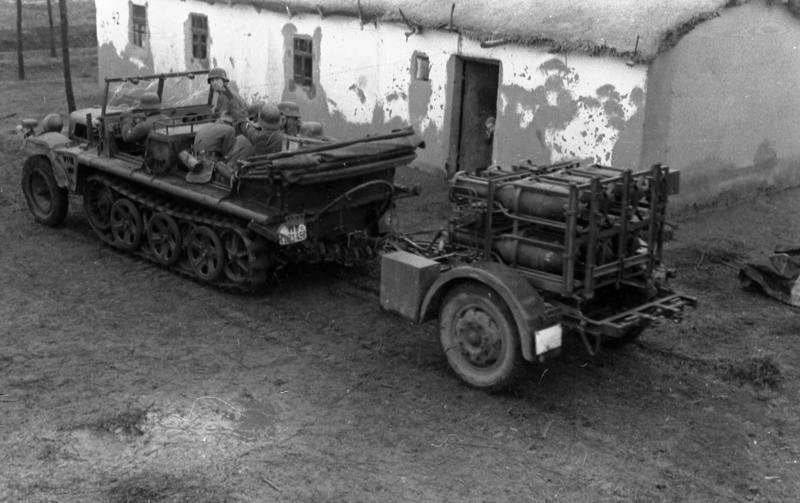
280-mm high-explosive missile loaded with 45,4 kg of explosives. With a direct hit of ammunition in a brick building, it was completely destroyed.
The warhead of an incendiary 320-mm incendiary missile was filled with an incendiary 50 (crude oil) and had a bursting explosive charge of 1 kg.
During the war, the Germans withdrew 320-caliber incendiary missiles due to their lack of effectiveness. In addition, thin-walled 320-mm incendiary projectiles were not very reliable, they often leaked fire mixture and burst on start-up.
280-mm and 320-mm missiles could be used without launchers. For this it was necessary to dig up the starting position. The mines in the boxes along the 1-4 pieces were located on leveled sloping soil over wooden decking. The rockets of the first issues at the start often did not come out of cappings and were fired along with them. Since the wooden boxes greatly increased aerodynamic resistance, the range of fire was significantly reduced and there was a danger of destruction of their parts.
Frames located in stationary positions were soon replaced by “heavy throwing instruments” (schweres Wurfgerat). The capping guides (four pieces each) were installed on a light metal frame or wooden machine, folding like a stepladder. The frame could be located at different angles, which made it possible to give PU elevation angles from 5 to 42 degrees. The combat weight of the wooden sWG 40 loaded with 280-mm rockets was 500 kg, with 320-mm ammunition 488 kg. For steel sWG 41, these characteristics were 558 and 548 kg, respectively.
The volley was made within 6 seconds, the recharge rate is about 2,5 minutes. Sights were very primitive and included only the usual protractor. Permanent calculations for the maintenance of these simple installations were not distinguished: any infantryman could fire from sWG 40 / 41.
The first mass use of 28 / 32 launchers, see Nebelwerfer 41, took place on the Eastern Front during the German summer offensive in 1942. They were especially widely used during the siege of Sevastopol.
There was also a “self-propelled” version of the 28 / 32, see Nebelwerfer 41. Sd.Kfz.251.1 Auf.D was mounted on the sides of the tracked armored personnel carrier to hang all three wooden launch frames for containers (three on each side, two for commanders).
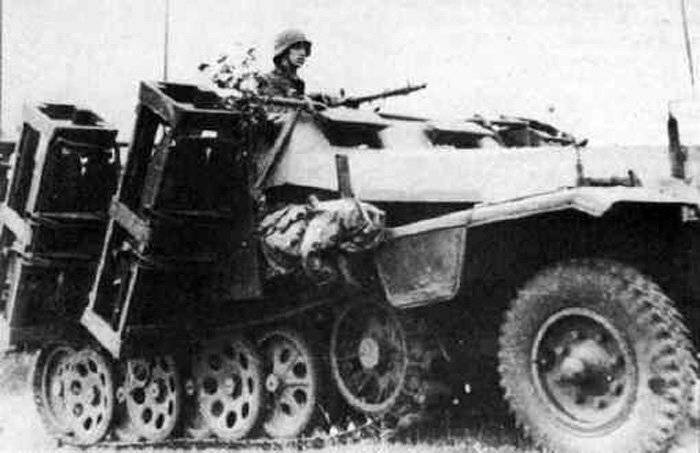
The armament of the BTR - two 7,92-mm machine guns (aft on the anti-aircraft turret) - was fully preserved. Next to the machine gun on the rod was attached primitive sight for coarse guidance. Such "self-propelled" MLRS arrived mainly in the SS troops.
Capping with large-caliber missiles were installed on other chassis. Thus, in the 1943, a few dozen double-armored Renault Ue armored vehicles captured by the Germans as trophies in the 1940 year were converted into self-propelled MLRS.
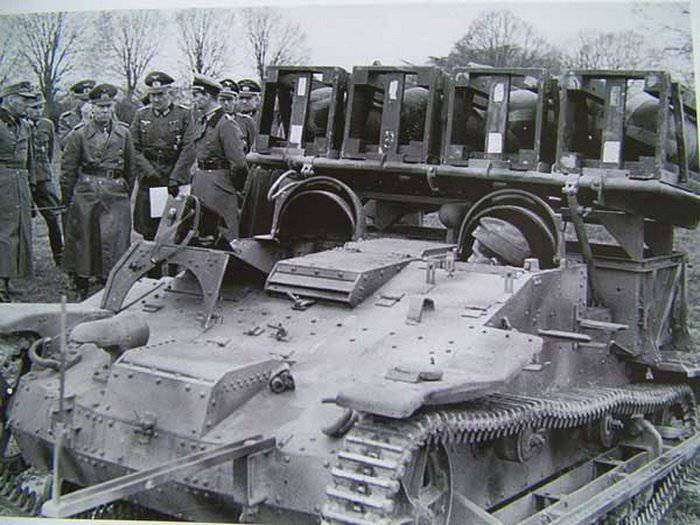
In the stern of the vehicle, guides for containers with jet mines were mounted, and in front of the frontal sheet, on the bar bore forward, was attached a primitive sight for coarse pick-up of weapons. Missile launch could be carried out from inside the tractor. Crew - two people. The speed of the tractor dropped to 22 km / h, but on the whole the car turned out to be quite reliable and unpretentious. The whole complex was named 28 / 32 cm Wurfrahmen 40 (Sf) auf Infanterieschlepper Ue 630.
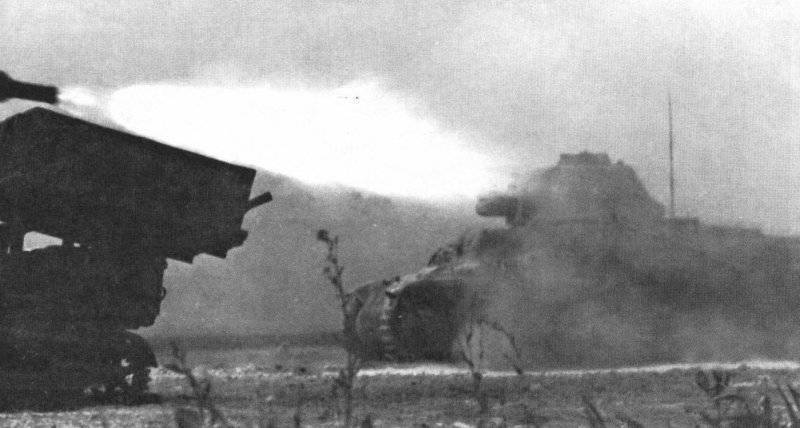
Also, launch frames with 280/320 mm missiles were mounted on captured French Tanks Hotchkiss H39.
During the war, the warring parties repeatedly copied from each other individual samples of equipment and weapons.
At the beginning of 1942, in the blockade Leningrad, the production of reactive mines was set up, repeating in their design the German 28 cm Wurfkorper Spreng and 32 cm Wurfkorper Flam. The high-explosive combat units that could not be better suited for the conditions of the "trench warfare" of the Leningrad front of projectiles were equipped with a surrogate explosive based on ammonium nitrate. Incendiary mines were filled with petroleum wastes, the igniter of the combustible mixture was a small explosive charge placed in a glass of white phosphorus. But incendiary 320-mm reactive mines were produced several times less than high explosive 280-mm.
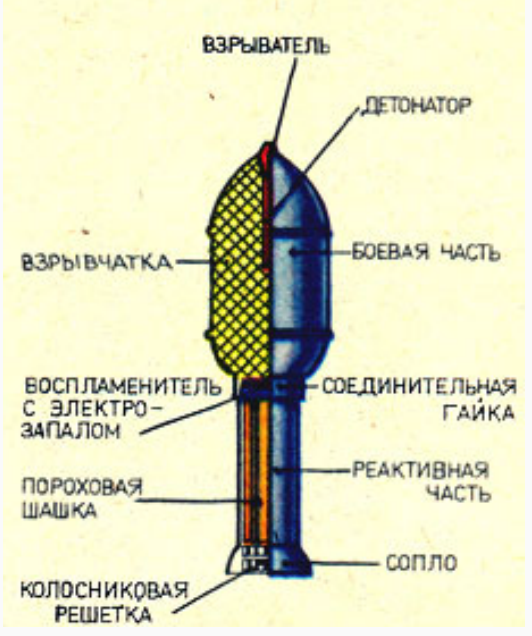
In total, more than 10000 280-mm reactive mines were produced. As the brainchild of the blockade, M-28 mine ended its existence with a blockade.
Based on:
http://forum.guns.ru/forummessage/42/73.html
http://ussrlife.blogspot.ru/2012/10/blog-post_3526.html
http://fs.nashaucheba.ru/docs/270/index-1543563.html
http://strangernn.livejournal.com/892595.html
- Sergey Linnik
- German rocket artillery during the war. 1-Part I
German rocket artillery during the war. 2-Part I
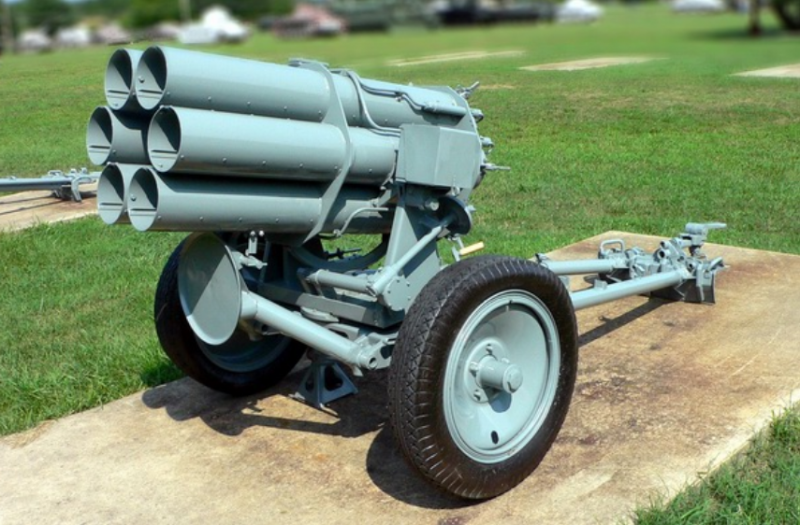
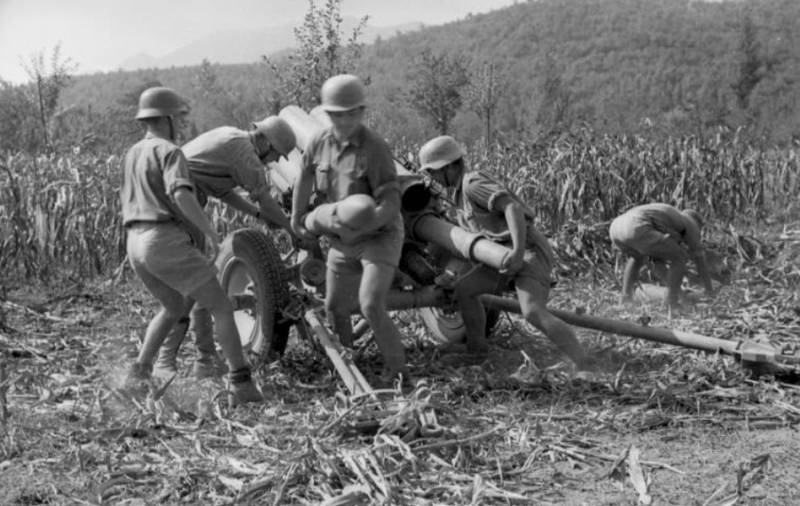
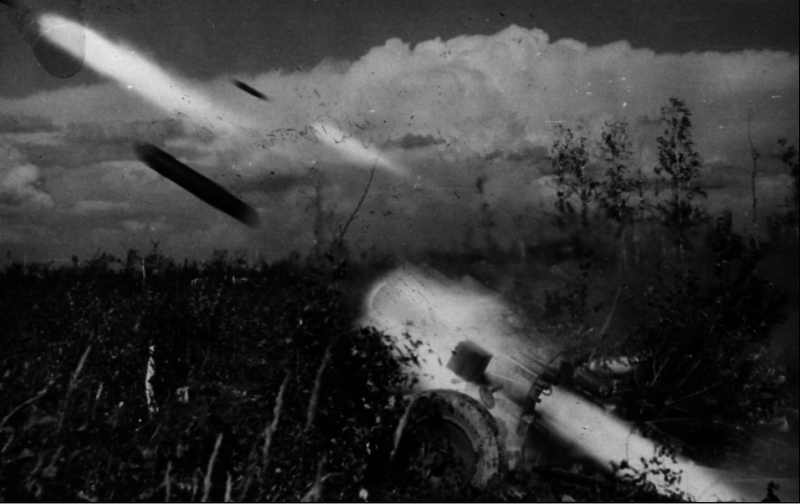
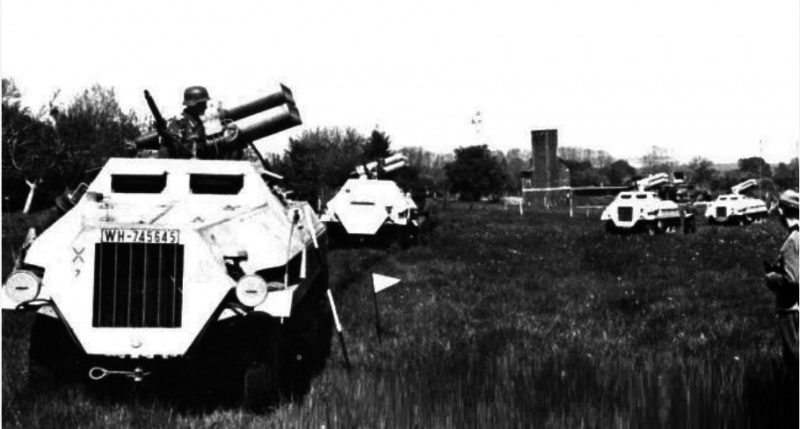
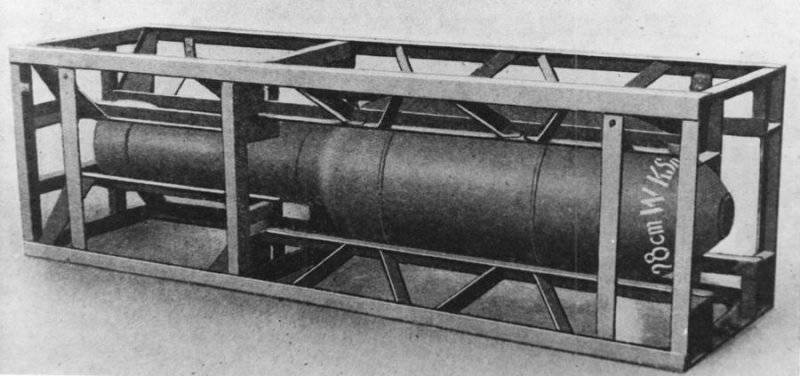
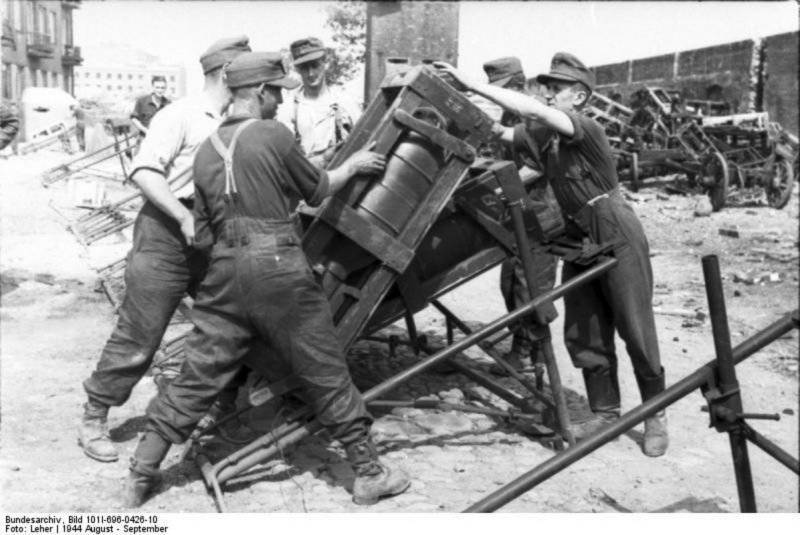
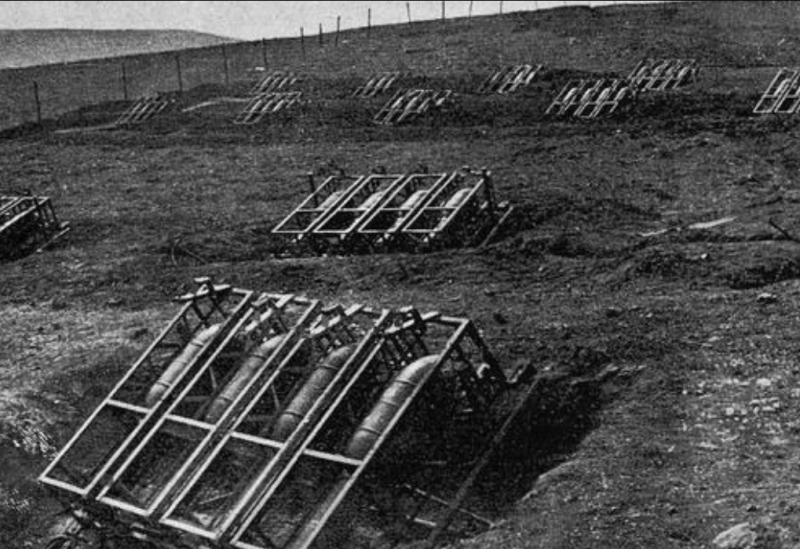
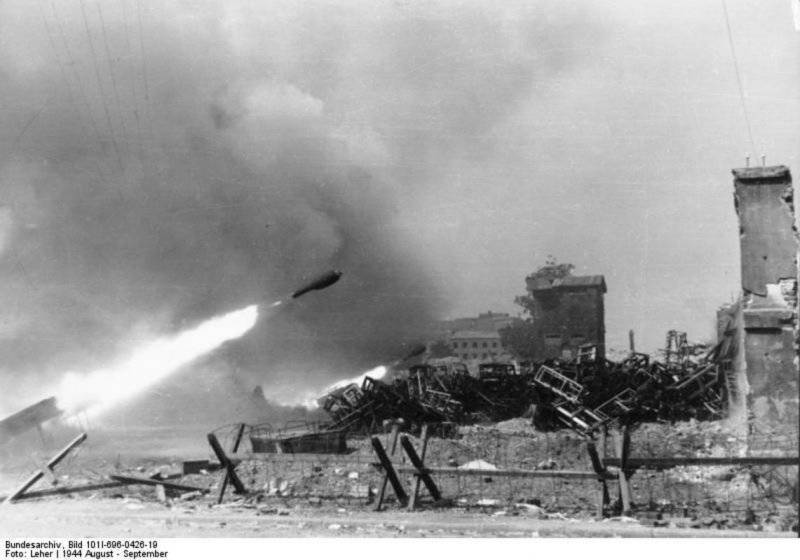
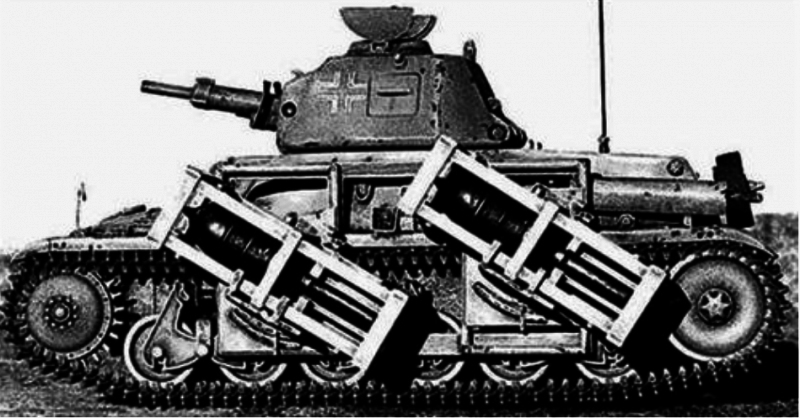
Information